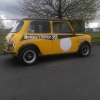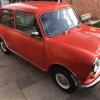In order of durability:
1) Polyurethane paint - this is the type of paint used to finish commercial airplanes, trucks, buses, trains, etc. It is the most durable paint commonly available. Once fully cured, it is so hard it's difficult to buff and polish, yet it is very flexible (not brittle at all.) The negatives are that it's a two part paint that uses chemical action to link its molecules to make it hard, and the activator is potentially lethal to breathe (isocyanate - i.e. cyanide based compound.)
It is more expensive in terms of paint cost and equipment to spray it safely, and because the paints are usually "high solids type" (more pigment and paint compound vs. carrier thinner, i.e. pretty heavy and thick) it takes some skill to paint successfully. Not for the beginner.
Other drawbacks are limited color selections (probably not too many pearls and candies available in polyurethane) though you could choose another type of paint for the base and use durable polyurethane as a clear coat. The polyurethane clear coats I've seen have a bit of a yellowish cast to them though, which might not be desirable for someone very particular about a paint shade.
2) Urethane paint - similar to polyurethane, but not quite as durable generally. This type of paint is the most common used by automotive refinishers and body shops. It too is a chemically activated paint, but its activators *can* (but are not necessarily) less lethal than polyurethane, especially if it isn't isocyanate based. Even if not, it is still bad to breathe and requires respirator equipment for protection.
It is still a very durable paint, and is available in practically any color. Any OEM color should be available in a urethane. With proper equipment an amateur could make a decent go at it with this type paint.
3) Synthetic enamel - an enamel is a paint that dries and cures both through solvent evaporation and chemical linking. (Polyurethanes and urethanes have this characteristic.) Here though, the molecules used in the paint are based on acrylic generally. The most important difference is that for many of these paints, an activator/hardener is optional. This makes them much safer to spray at home.
One drawback is that the paint isn't as durable as urethane, though not bad for a car that is reasonably well maintained and protected, and certainly is more prone to cracking. It isn't as flexible. But, remember how I just mentioned how these paints harden through chemical action? Well, if you don't have a oven to bake the enamel, the chemical hardening action literally takes months at room temperature. You have to be real careful not to get any dust on the car after painting for at least 1 day if not longer, and you dare not polish or buff it for at least a couple months (I'd wait at least 6 months.) You can add a chemical activator to speed the hardening process, but the activator puts you back in need of a respirator for protection of your lungs.
If a beginner or amateur can protect the car from dust, it's a reasonable product for home use but beware getting a run in the paint. With an activator, you can at least sand down runs or fix painting defects soon after painting. Without activator, you can't do anything about it for months unless you strip and repaint.
4) Lacquer, which I think sometimes is termed cellulose - this type paint dries and cures solely by solvent evaporation. It is the easiest paint to spray for a beginner or amateur. But it is also the least durable by far, easily stained by fuel, tar, bird droppings, etc, and is very prone to chipping (not very flexible.) It was a staple of show cars that rarely if ever see the road, and it is easy to sand and polish. But it also illegal in many countries or regions because the volatile thinners used to carry the paint are very polluting. Unless you like touching up your paint all the time, it's not recommended for a regularly driven vehicle.
As for candies and pearls - these are among the hardest to spray. First, you have to get the metallic "grain" just right and consistent. If you spray one section one way and other section another way, the difference will be obvious from various angles because the metallic particles will be lying in a different orientation. You will see the the light reflected differently because of the way the metallic particles have settled in the paint (aka "flip-flop".)
Then you have to protect the paint with a clear coat. A clear coat is mandatory with a metallic. Finally, if the paint is damaged and needs to be repaired, it take considerable skill to match metallic paints. Often an entire panel has to be repainted to fix a small scratch or chip, if you want it to look perfect, and even if the panel is repainted the painter has to have the skill to match the "flip-flop" of the other panels as well.















